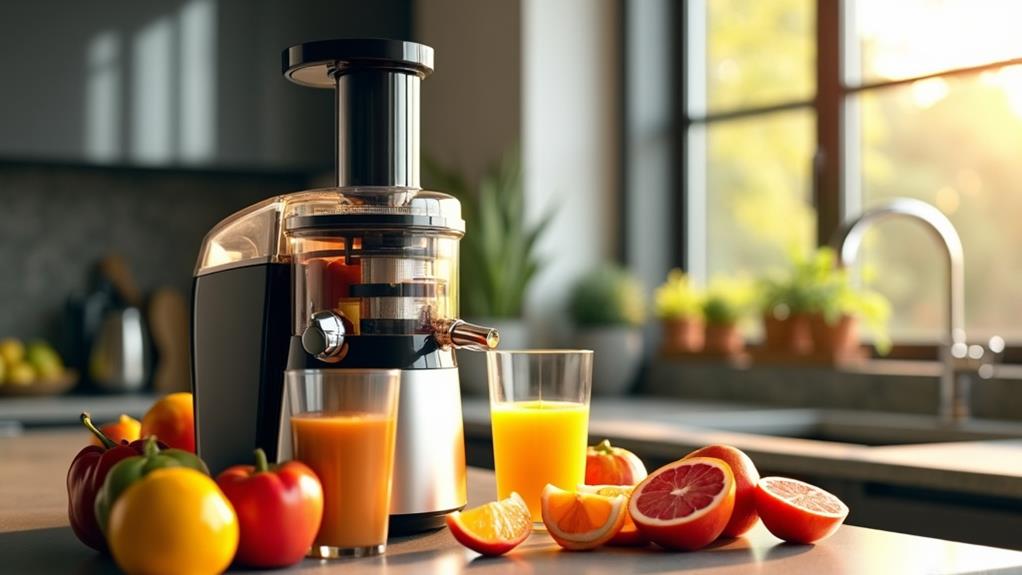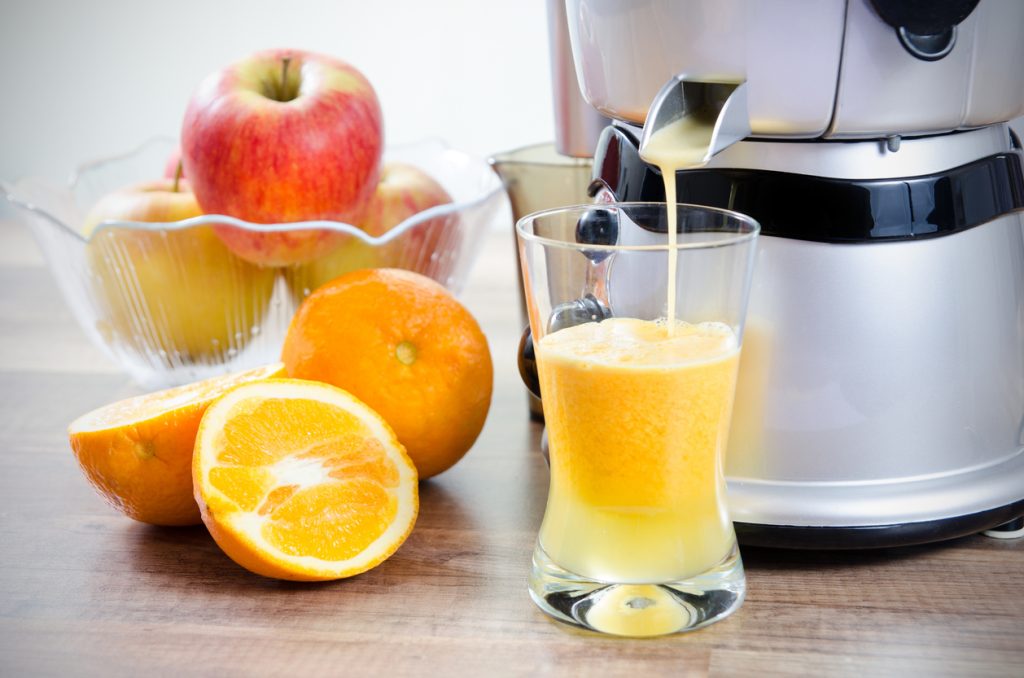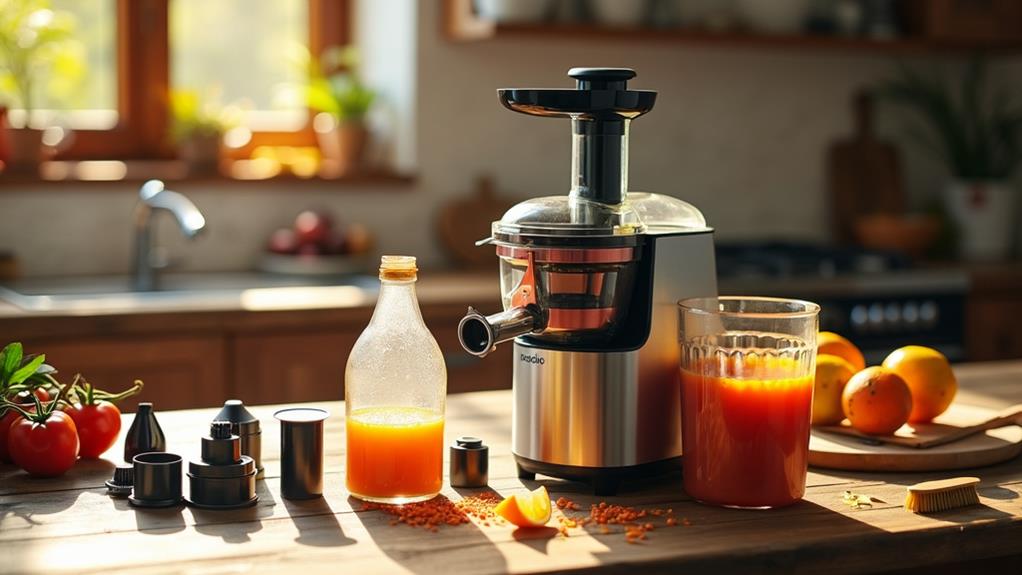Understanding Juicer Speed Settings for Optimal Juice Extraction

To optimize juice extraction, adjust your juicer's speed based on produce type. Centrifugal juicers run at high speeds, suitable for quickly juicing hard fruits but may lose nutrients. Slow juicers, operating at low speeds, are perfect for leafy greens, preserving more nutrients and flavor. Use medium speeds for soft fruits to balance juice quality and yield. Speed settings also impact foam and pulp consistency, so experimenting will help find your ideal juice texture. Properly prepare and chop ingredients for smoother operation. Storing juice in airtight containers preserves its freshness. Want to improve juicer longevity and performance? There's more to investigate!
Juicer Types and Mechanics
Regarding juicing, understanding the mechanics of different juicer types is essential. Centrifugal juicers, for instance, operate at high speeds of 3000 RPM or more, using a fast-spinning blade that quickly breaks down produce. This rapid juice extraction is convenient but can lead to nutrient loss due to oxidation. If you value speed and efficiency, these juicers might suit your lifestyle, especially when time is of the essence.
On the other hand, slow juicers, also known as masticating juicers, work at lower speeds, employing an auger to crush and squeeze fruits and vegetables. This method results in higher juice yields and better retention of nutrients in the juice. Slow juicers process ingredients more thoroughly, enhancing both flavor and nutritional value. They're ideal if you prioritize nutrient density and juice quality over speed.
Twin gear juicers, a subtype of slow juicers, can achieve faster extraction rates while still preserving nutrient quality. This makes them an excellent choice for health-focused individuals who don't want to compromise on juice quality. Ultimately, choosing between these juicer types means balancing speed and the desired quality of nutrients in the juice, aligning with your personal health goals.
Speed Settings and Juice Quality
Understanding juicer speed settings is crucial for maximizing juice quality and nutrient retention. When you use a slow juicer, which operates at 40-100 RPM, you're able to extract nutrients and enzymes more effectively without generating heat. This low-speed process is key to preserving the juice quality, especially when dealing with softer fruits. Slow juicers, such as masticating juicers, offer the advantage of multiple speed settings, allowing you to tailor the juicing process according to the type of produce. This customization is particularly beneficial for maintaining the integrity of the juice while maximizing juice yield.
Masticating juicers excel in producing higher juice yields, typically 15-20% more from hard-to-juice ingredients like leafy greens compared to centrifugal juicers. By starting at a low speed with softer fruits and greens, you're guaranteeing that the juicer doesn't clog and juice extraction is optimized. Contrast this with centrifugal juicers, which can spin at 3000 RPM or more, risking oxidation and nutrient loss, especially in softer produce. By understanding and using the appropriate speed settings, you can considerably improve the juice quality and guarantee you're getting the most out of your ingredients.
Ingredient Preparation Tips

Proper ingredient preparation is key to an efficient and enjoyable juicing experience. Start by thoroughly washing and cutting your fruits and vegetables. This simple step greatly improves the juicing process by reducing preparation time. Regarding peeling, keep in mind that citrus fruits and pomegranates should be peeled to improve both juice extraction and flavor. On the other hand, fruits like apples and carrots can go straight into the juicer without peeling, saving you time.
Chopping produce into smaller pieces is one of the vital ingredient preparation tips. It helps prevent clogging, ensuring smoother juice extraction and reducing the risk of machine malfunction. This is particularly crucial for harder fruits and vegetables, which can be tough on your juicer if not adequately prepared.
For ideal results, refer to your juicer's user manual to determine the best speed settings for soft fruits versus harder fruits and vegetables. Preparing ingredients in advance can also streamline your morning routine. Portion them into bags the night before, so you're ready for quick and convenient juicing sessions. With these preparation tips, you'll enjoy a seamless juicing process and a delicious, invigorating juice every time.
Optimal Nutrient Extraction
To get the most nutrients from your juice, consider using a slow juicer that operates at lower speeds. Unlike centrifugal juicers, which spin rapidly and generate heat, slow juicers work by grinding and squeezing the produce. This method improves nutrient extraction by breaking down plant fibers more effectively. As a result, you get juice with the best quality, retaining more nutrients and enzymes essential for your health.
Slow juicers offer significant health benefits. They preserve the integrity of the juice, minimizing oxidation and nutrient loss. This means the juice retains its nutritional value longer—up to 72 hours when stored properly in airtight containers. The nutrient-rich juice from the pulp is not only fresher but also more potent, giving you an increase of vitamins and minerals.
Moreover, slow juicers can yield 15-20% more juice compared to centrifugal models, especially when juicing leafy greens and soft fruits. This efficiency guarantees you make the most of your produce, extracting every last drop of goodness. So, if you're serious about getting the maximum health benefits from your juicing efforts, investing in a slow juicer is a wise choice.
Pulp Utilization Ideas
How can you make the most of the leftover pulp from your juicing sessions? Don't let that nutritious byproduct go to waste! The pulp from your fruits and veggies still contains fiber and nutrients, making it a fantastic supplement to diverse recipes. Here are some ideas to get improved results from your juicing efforts:
- Baked Goods: Incorporate pulp into muffins, pancakes, or energy bars. It adds texture, flavor, and health benefits, offering crucial vitamins and minerals while reducing waste.
- Soups and Casseroles: Fresh pulp can improve your soups and casseroles by adding thickness and moisture. This not only increases flavor but also enriches the nutritional content of your meals.
- Freezing for Later Use: If you can't use the pulp immediately, freeze it in airtight containers. This preserves its nutritional value, allowing you to incorporate it into your cooking or baking whenever you're ready.
- Composting: If cooking isn't on your agenda, consider composting the pulp. It's an excellent material for compost bins, contributing to healthy soil and promoting sustainability in your kitchen.
Storage and Freshness Guidelines
Storing your freshly made juice properly guarantees you get the most out of its nutrients and flavor. After whipping up a delicious blend of fruits and leafy greens, it's essential to prioritize the storage of your juice to maintain its quality and freshness. Ideally, you should consume your juice immediately, but when that's not possible, use airtight containers to store it in your refrigerator. This method helps retain nutrients for up to three days without significant loss.
To make sure your juice stays fresh, opt for dark glass or opaque containers. These limit light exposure, which can degrade the nutrients in your juice. Always fill these containers to the brim to minimize air contact, reducing the risk of oxidation and preserving that quality juice taste.
Maintenance and Cleaning Practices

After guaranteeing your juice retains its freshness and nutrients, it's just as crucial to keep your juicer in prime condition. Regular maintenance not only maintains its performance but also extends its lifespan. Start by disassembling the juicer components after each use. Rinse them under warm water to prevent pulp and residue buildup, which can compromise efficiency and hygiene.
- Clean thoroughly: Use a cleaning brush to scrub mesh filters and tight spaces, confirming all pulp is removed.
- Follow guidelines: Always adhere to the manufacturer's cleaning techniques and solutions to avoid damaging parts.
- Dry components: Make certain all parts are completely dry before reassembling, preventing mold and unpleasant odors.
- Inspect regularly: Conduct routine maintenance checks, inspecting seals and gaskets for wear to avoid leaks and guarantee peak performance.




